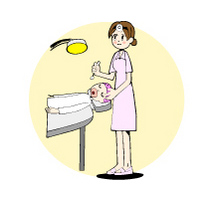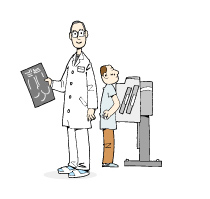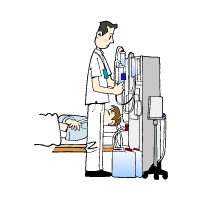人里に現れ、人間や農作物に大きな被害【環境】

【里山の崩壊で野生動物の生態系に変化】
日本各地で野生動物が人間に危害を与えたり、農作物を荒らすといったニュースがしばしば報道されています。農林水産省が調査を始めた1999年度以降、野生鳥獣による農作物の被害額は毎年200億円前後で推移しています。こうした被害は、被害額として現れる以上に、日本の社会に暗い影を投げかけています。日本人が古くから育み、利用してきた里山が崩壊の危機にさらされ、そこに住む野生動物が住処を追われて人里に出没し、さまざまなトラブルを頻発させているからです。
Serious damage to human beings and crops
【Wildlife and ecosystems change by the collapse of satoyama】
Wild animals harming human beings and destroying agricultural crops in various places in Japan are often reported in the news. The amount of wildlife damage to crops has hovered at around 20 billion yen since 1999 when the Ministry of Agriculture, Forestry, and Fisheries started investigating. Damage to crops by wild animals is casting dark shadows on Japanese society. Satoyama, which the Japanese have nurtured and used for a long time has been on the brink of collapse. Wild animals living there are deprived of residence, and they enter human habitations. Various troubles have frequently occurred.
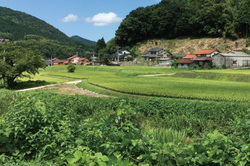 - 「里山」とはどういった地域? -
- 「里山」とはどういった地域? -日本は山国で、約70%が森林に覆われています。このため、狭い平野部は稲作を中心とした農地として耕され、農地は山裾まで広がっていきました。「里山」とは、人々の居住区や農地と隣接する「裏山」や「山」の総称で、古くは尾張藩が作成した「木曾山雑話」の中に記されています。
今日のように「里山」と呼ばれるようになったのは、1960年代後半に京都大学の四手井教授が「里山」の概念を定義付けたことで広く普及していきました。林学では、農家や農地に隣接する低山を「農用林」と呼びますが、「里山」という親しみやすく詩的な響きを醸し出す表現が普及していったのは納得です。
- What kind of place is satoyama? -
About 70 percent of Japan's land surface is mountainous. Therefore, narrow plains are cultivated as farmland mainly for paddy rice, and farmland spreads over the foot of the mountain. "Satoyama" is a generic term for "mountain behind" and "mountains" close to human habitations and farmland, and it is written in "Kisoyamazatuwa" created by Owari clan.
Tsunahide Shidei, a teacher at Kyoto University was the person who defined the concept of satoyama in the early 1960s. In forestry, low mountains adjacent to farmland are called "farm forest". It is easy to understand that friendly and poetic expression "satoyama" spreads widely.
- 里山の利用と保護の歴史 -
人間と里山の関係は、縄文時代にまで遡ります。青森県の三内丸山遺跡では、近くの森にクリやウルシなどを植えて食料として利用していました。飛鳥時代に入ると、食料の確保とともに建築資材として森林の伐採が進みました。日本書紀によると、676年に天武天皇が近郊の里山での木の伐採を禁じる勅令を出したと記されています。
江戸時代に入ると、人口の急増に伴って建材の需要が高まり、森林破壊が深刻化していきました。この結果、河川の氾濫や台風の被害の拡大など深刻な問題に直面しました。徳川幕府は17世紀後半、問題の解決を目指して伐採規制など森林の保護政策を打ち出しました。このように、日本は縄文時代から里山の利用と保護を繰り返してきたのです。
- History of use and protection of satoyama -
The relationship between human beings and satoyama dates back to the Jomon period. People planted chestnuts and sumacs, and ate them at the Sannai-Maruyama Archaeological Site in Aomori Prefecture. In the Asuka period, forests were cut down for building materials and securing food. According to an article recorded in the "Nihonshoki", Emperor Tenmu issued an Imperial order to prohibit the logging of trees in the vicinity of satoyama in 676.
In the Edo period, the demand for building materials increased with a rapid increase in the population, and the destruction of forests advanced. As a result, people faced serious problems such as river floods and expansion of typhoon damage. In the latter half of the 17th century, the Tokugawa shogunate adopted a forest protection policy, and set up strict regulations towards logging to solve the problem. In this way, Japan has repeatedly used and protected satoyama since the Jomon Period.
- 人間と鳥獣が共生する豊かな世界 -
里山は、建築資材の供給だけではなく、人間の経済活動を支える重要な役割を果たしてきました。まず燃料としての利用です。材木は燃料として食物の煮炊きに利用されるだけでなく、風呂を沸かし、暖房にも利用されました。農村では、木炭を製造して都市部に供給することで、経済活動の一翼を担うようになりました。建築資材に欠かせない杉やヒノキは、里山で50~100年間隔で伐採、植林を繰り返しながら提供されてきました。
里山には、樹木の樹液を求めて多くの昆虫が群がります。こうした昆虫や木の実を目当てに野生鳥獣も駆けつけ、人間と動物が共存・共栄する豊かな世界を作り出していきました。
- A rich world where birds, animals and human beings live together -
Satoyama has played an important role not only in supplying building materials but also in supporting economic activities. First of all, it is used as fuel. Wood can be used for cooking, occasionally for boiling bath and heating of room. In rural areas, producing charcoal and supplying it to urban areas activated economic activity. Cedars and cypresses indispensable for building materials have been provided by repeated logging and afforestation every 50 to 100 years in satoyama.
Many insects gather around satoyama for the tree sap. Wild birds and animals appear to seek such insects and tree nuts. Human beings and animals have created a rich world to enjoy mutual prosperity.
- 戦後、急速に進んだ里山の崩壊 -
太平洋戦争で石油の輸入がストップした日本は、エネルギー源を木材など国内資源に頼らざるを得なくなりました。この結果、里山はもちろん、森林の奥深くまで伐採され、全国各地の森林は疲弊し崩壊していきました。
戦後、政府は国土緑化推進運動を繰り広げ、丸裸になった山への植林を推進していきました。この時、森林経営を導入したことで、クヌギやブナなどの広葉樹より価値が高いとされるスギやヒノキを植林し、里山は針葉樹の森に変貌していきました。
この頃、日本にエネルギー革命が押し寄せ、従来の薪や炭、石炭などに変わって、石油、ガス、電気がエネルギー源になっていきました。価値の高い針葉樹の植樹で期待された林業も、安価な外国産の木材が輸入されることで壊滅状態に陥りました。
この結果、若者は農村を離れて都市部に職を求め、農家の数は減少していきました。また、農業は機械化され、化学肥料の使用で生産性が向上し、人が田畑にいるのは農繁期に限られ、しかも老人が目立つようになりました。
- Collapse of satoyama advanced rapidly after the war -
Japan's oil was shut off during the Pacific War, Japan had to depend on domestic resources including wood as an energy source. As a result, trees were cut down in the deep forest. Forests were exhausted and collapsed throughout Japan.
The government promoted the national land afforestation promotion campaign after the war and promoted afforestation of the naked mountain. Conifer trees such as Japanese cedar and Japanese cypress are more valuable than broadleaf trees such as oak and beech. Satoyama transformed into conifer forests by introducing forest management.
Being affected by the energy revolution at that time, the long-lasting charcoal-making business was discontinued, and oil, gas, and electricity became energy sources. Forest industry was expected to improve by planting valuable coniferous trees, but it was totally destroyed due to the import of cheaper foreign wood.
As a result, the flow of young population from rural to urban areas has increased, and the number of farmers has declined. In addition, the agriculture has been mechanized, the use of chemical fertilizers improves agricultural productivity, and people especially the elderly are in the field only during the agricultural season.
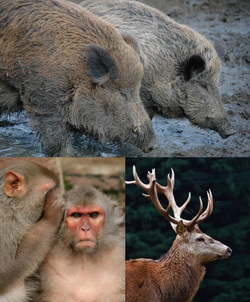 - 里山の崩壊で野生動物が人里に出没 -
- 里山の崩壊で野生動物が人里に出没 -かつて、野生動物は里山で人々が農作業をする間は森で身を休め、仕事を終えると里山に現れて自由に行動していました。里山は人間と動物の程よい緩衝地帯でもあったのです。
日本は温帯で雨量も多いため、里山は伐採されてもすぐに草木が生え、動物の好物となる木の芽をつける樹木が育ちます。しかし、農業や林業従事者の激減で里山は放置され、樹木は鬱蒼と茂って動物が求める下草の成長は見込めなくなりました。
里山で生れた動物の子供たちは、人間との付き合い方を知らないまま成長していきます。そして、好物が少なくなった里山から人里に現れて、美味な農作物や人間の食べ残しなどを食するようになりました。農作物や人間の食べ物の味を覚えた動物たちは、その後も頻繁に人里に現れ、そこで暮らす人々とトラブルを引き起こしているのです。
- Wild animals frequently stray into human habitation due to the collapse of satoyama -
In the past, wild animals rested in the forest while people were working on the farm in satoyama, and when people finished their work, wild animals appeared and acted freely. Satoyama was also a buffer zone between human beings and animals.
Because Japan belongs to the temperate zone and has a lot of rain, trees, and plants grow immediately after being harvested. However, due to the sharp decline in the number of agricultural workers and forestry workers, satoyama became abandoned forests. Trees became dense and the undergrowth that animals needed could not expect to grow.
Baby animals born in satoyama grow up without knowing how to get along with human beings. Animals come down to human habitation from satoyama, which is short of food, and eat delicious farm products or human leftover. Animals that remember the taste of agricultural crops frequently appear in the village, and cause trouble with people living there.
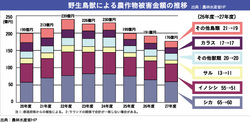 - 被害の大半を占めるシカ、イノシシ、サル -
- 被害の大半を占めるシカ、イノシシ、サル -野生鳥獣による農作物の被害額は、近年200億円前後で推移しています。2015年度の野生鳥獣による農作物被害は約176億円で、鳥類による被害は全体の約20%の35億円程度で、残る141億円は野生動物による被害となっています。野生動物の中では、シカ、イノシシ、サルによる被害が約7割を占めています。近年、シカとイノシシによる被害の増加が目立っています。これら3種の野生動物は、生息域を全国に拡大し、北海道、福岡県、長野県、山形県、宮崎県などで大きな被害を及ぼしています。
被害地域が拡大しているのは、野生動物たちが餌場となる里山を求めて人里を通過し、新たな里山に移動するためです。さらに、野生動物の保護という世界的風潮、狩猟者の減少や高齢化で狩猟による捕獲数も大幅に減少しています。
人間と野生動物が共存・共栄できる自然環境の再構築、「里山」の復活で人間と野生動物が共に安心して暮らせる自然環境の創出が待ち望まれています。
- Deer, wild boar, and monkey, which cause most of the damage -
The amount of field crop damage due to the wild birds and beasts has remained around 20 billion yen in recent years. Crop damage by the wild birds and beasts of 2015 was approximately 17.6 billion yen. Bird damage was approximately 20% of the total, or around 3.5 billion yen, the remaining 14.1 billion yen was wild animal damage. Deer, wild boar, and monkey account for about 70% of the damage by wild animals. Damage caused by deer and wild boar is outstanding in recent years. These three kinds of wild animals have expanded their habitats nationwide, especially in Hokkaido, Fukuoka prefecture, Nagano prefecture, Yamagata prefecture, Miyazaki prefecture.
The damaged area is expanding because the wild animals pass through the villages in search of satoyama, and move to a new satoyama. In addition, the number of animals captured largely decreases by the global trend of protecting wildlife, and decreasing and aging of hunters.
Reconstruction of the natural environment that human beings and wild animals can coexist and co-prosper and revival of "satoyama" are expected.





